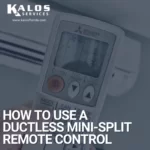You may have gone over to a friend's house or spent some time in their lanai and noticed a small A/C unit high up on their wall. Maybe you even have one of these small HVAC systems in your own home. We call these units ductless mini-splits; as their name suggests, a ductless mini-split is a small version of a typical split system, and they lack ducts.
These units can heat or cool your home and run quietly, and we find that they tend to do a good job. However, they operate differently from your typical split HVAC systems. We're going to cover some of the unique traits and common uses of ductless mini-splits to help you decide if they might be right for you. This article will also explain why you may want to call a Mitsubishi Elite Diamond Contractor if you decide that a mini-split is right for you.
INSIDE A TRADITIONAL HEAT PUMP SYSTEM
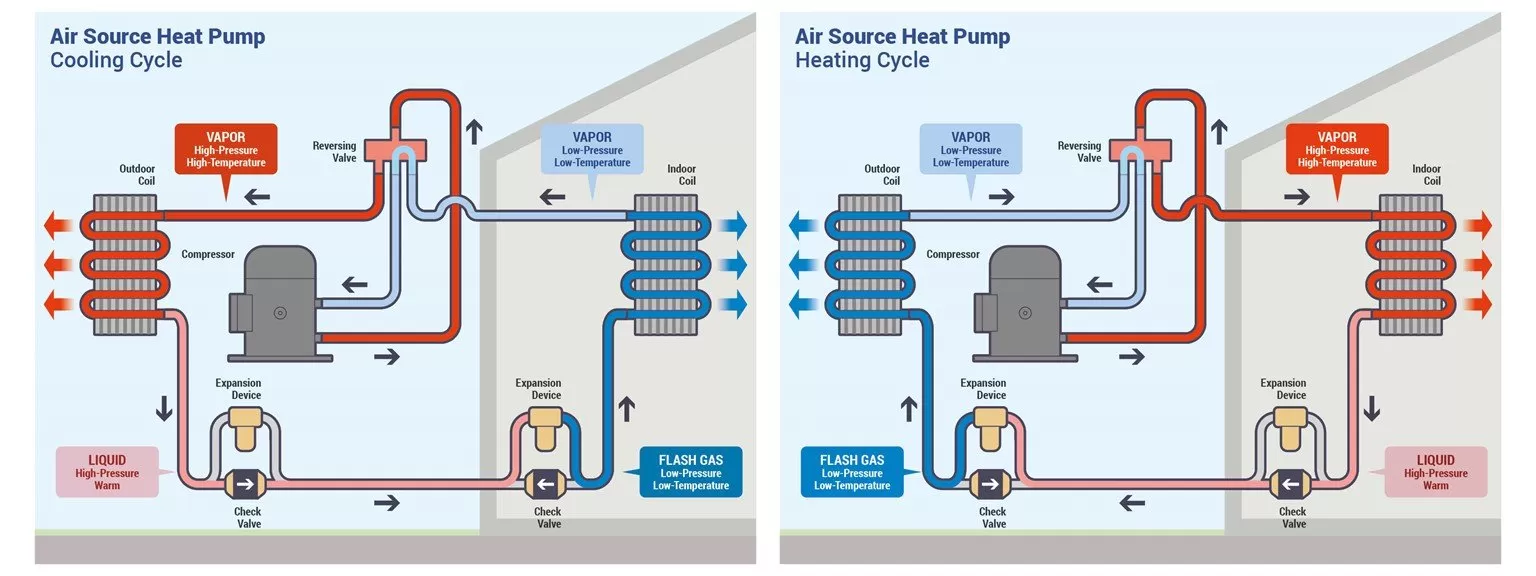
A traditional air-source heat pump isn't a pump at all; it's actually quite like a straight-cool A/C unit. However, a heat pump can reverse the refrigeration cycle to heat the home as well. Heat pumps provide heating by bringing outdoor heat inside the home.
In the cooling cycle, a heat pump uses liquid refrigerant (often called by the brand name “Freon”) to absorb heat from inside the home at the evaporator. That refrigerant vaporizes and goes to the compressor via the suction line. The compressor then raises the temperature and pressure of the refrigerant by squeezing it into a smaller space. Then, the refrigerant leaves the compressor via the discharge line and goes to the condenser. There, it rejects heat to the outdoors. (The refrigerant rejects heat because compression has made it hotter than the outdoor air; therefore, the heat naturally moves to the place with the lower temperature.) At that point, the refrigerant loses enough heat to become a high-pressure liquid, and it travels through the liquid line to a metering device, which drops the pressure. Metering devices tend to be TXVs or fixed-orifice pistons. From there, the cycle repeats itself.
In the heating cycle, a part called the reversing valve shifts the lines that go into and out of the compressor. So, the indoor unit (cooling mode evaporator) becomes the condenser, and the outdoor unit becomes the evaporator. The system absorbs heat outdoors and rejects it to the indoor space.
Heat pumps also have check valves, which route the refrigerant to one of two metering devices. Each operating mode uses its own metering device, and the check valves allow the refrigerant to bypass the device that is not in use.
INSIDE A DUCTLESS MINI-SPLIT
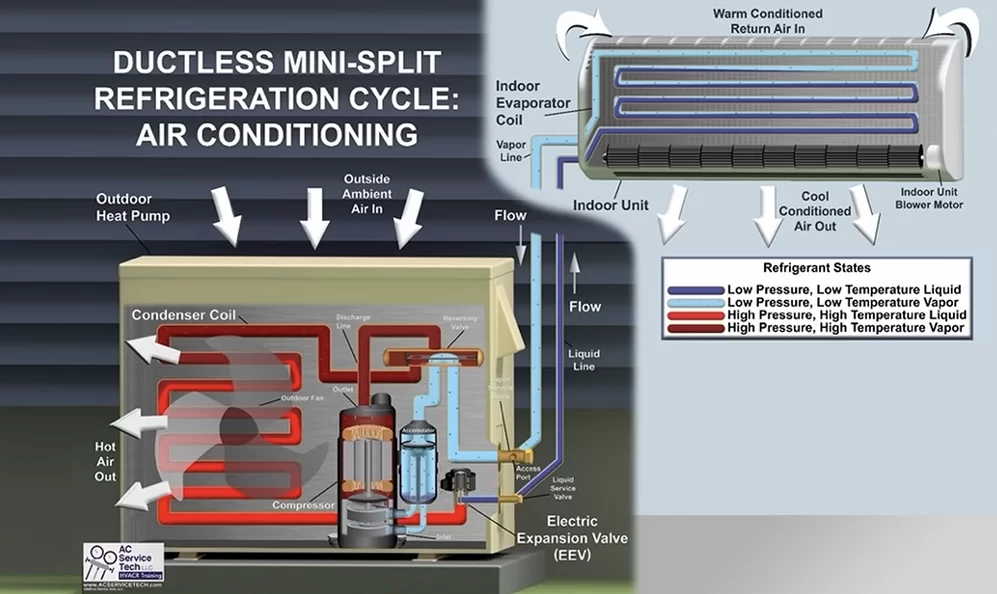
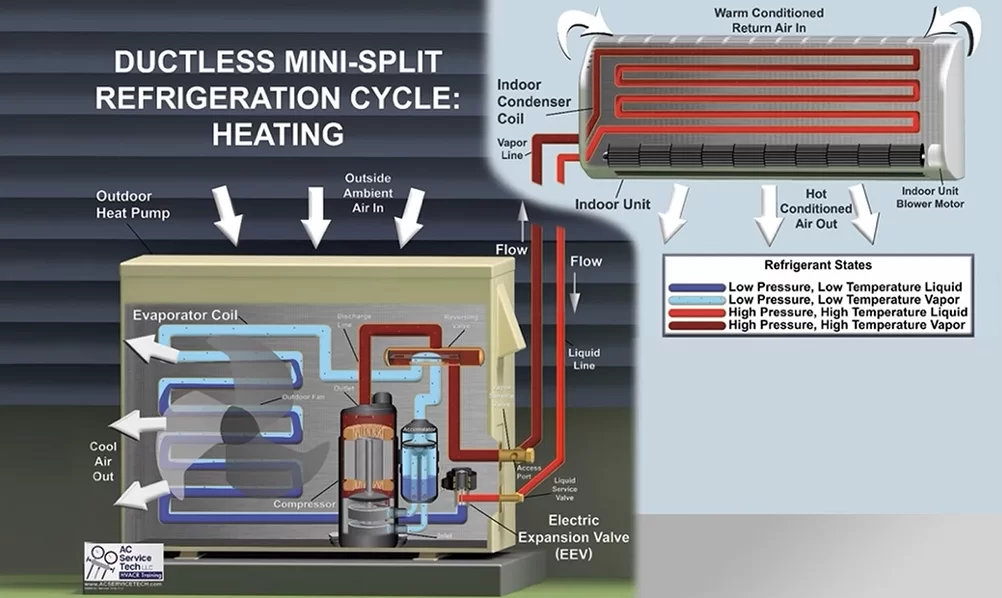
Illustration credit: Craig Migliaccio (AC Service Tech; https://www.acservicetech.com/)
We can expect a typical ductless mini-split to have the same general refrigeration cycle as an ordinary heat pump. However, they often have a different type of metering device: an electric expansion valve or EEV.
EEVs are unique in that they rely on information from control boards to modulate themselves. Fixed orifices (pistons) can't modulate at all, and TXVs are mechanical devices that respond to pressure from three different sources. Like a TXV, the EEV can modulate itself and change the size of its opening. The EEV differs from the TXV because it uses a stepper motor that gathers feedback from a control board, not three different forces, to adjust its opening.
In many traditional heat pumps, the metering device feeds directly into the evaporator. However, many ductless mini-splits have another line leading from the metering device to the evaporator; we call that the expansion line or flash gas line. That line takes the metered refrigerant (low-temperature, low-pressure liquid) and sends it to the evaporator coil. After the metering device, some of the liquid refrigerant will boil off due to the sudden pressure drop; that is called “flash gas,” and that's normal in the expansion line and beginning of the evaporator.
Also, instead of having ducts to multiple regions of the home, a ductless mini-split focuses on conditioning the room where it has been installed. So, mini-splits tend to be good options for people who want A/C and heating in their sunroom or lanai.
DUCTLESS MINI-SPLIT UNIT CONFIGURATIONS
Nowadays, we can install ductless mini-splits in multiple configurations. It's also worth noting that mini-splits can come in ducted varieties, but we will just discuss ductless ones.
Mini-splits may come in the form of high-wall units, which are mounted high up on the wall. There are also ceiling cassettes, which recess into the ceiling. (You can watch two Kalos installers set up a ductless Mitsubishi cassette system HERE.) There are even commercial ductless systems called variable refrigerant flow (VRF) systems.
In many cases, a one-to-one system with a single outdoor and indoor unit works just fine for a single room. That's especially true of people who like to have heating and A/C in their lanais. However, there are also multi-zone configurations that place multiple ductless “heads” (indoor units) throughout the building. These ductless heads would all trace back to a single condensing unit outdoors. Bryan Orr, the president of Kalos, installed a multi-zone ductless mini-split system in his own home. You can watch what goes into the installation of an additional head below:
SPECIAL CONSIDERATIONS
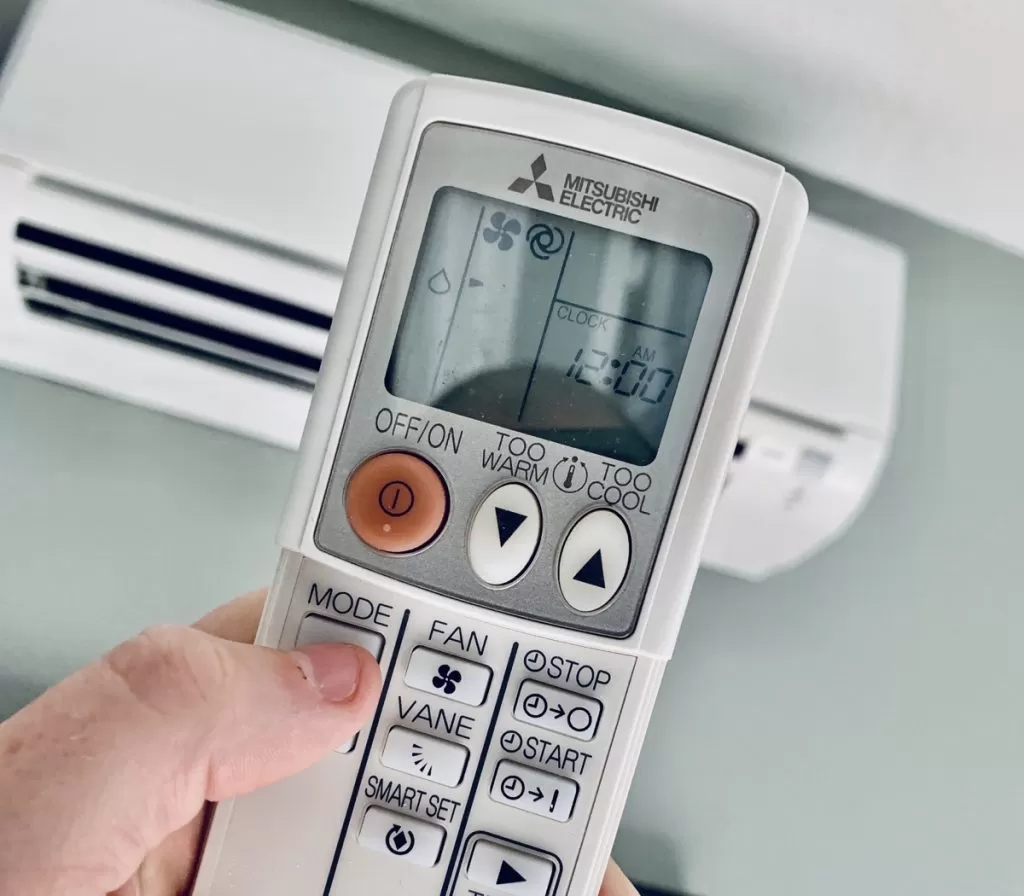
Ductless mini-split systems are unique and will suit some people's needs better than others.
One of the best aspects of the ductless mini-split is its efficiency. These units are all-electric and can have efficiency ratings of up to 30+ SEER; if you want to learn more about SEER ratings, check out our article about it at https://www.kalosflorida.com/air-conditioning/what-is-seer-and-why-does-it-matter/. These units have a very small carbon footprint and don't take up much space in your home, either, so their compactness makes them appeal to people who want small units and care about energy efficiency.
The ductless mini-splits we install are also quiet. So, if you want to install a ductless mini-split in a place like a bedroom or home gym, you won't have to worry about being bothered by a loud A/C unit.
More so than typical A/C units, ductless mini-splits work to condition their respective room. Although they may only require short runtimes, many mini-split units continue running at a low speed. That low speed typically isn't enough to provide continuous dehumidification.
As a result, many ductless mini-splits come with a dehumidification mode, which runs the unit at a set speed on a timer to dehumidify the space. However, it's not a great idea to rely on that mode alone for dehumidification; that mode may result in building occupants getting too cold and surfaces in the room reaching the dew point. In some cases, the condensation that forms on surfaces at the dew point may lead to microbial growth. You may need to consider investing in a dehumidifier in cases where the ductless mini-split can't keep up with the indoor humidity. (Learn more about Kalos's approach to installing whole-home dehumidifiers at https://www.kalosflorida.com/air-conditioning/do-dehumidifiers-really-work/.)
MAINTENANCE
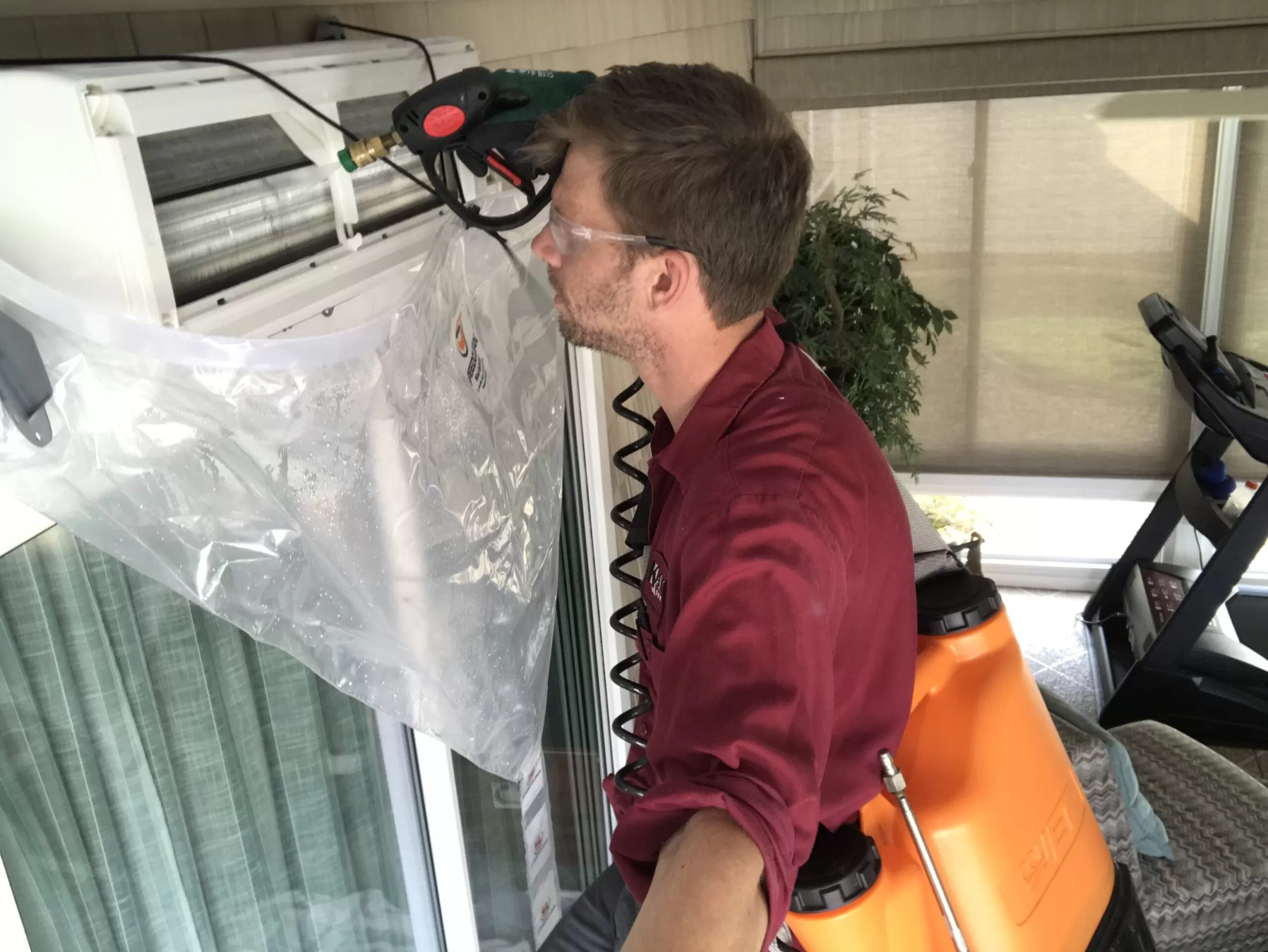
As with any other type of HVAC system, ductless mini-splits require regular maintenance.
Ductless mini-splits are a lot more compact than most other split systems, so they generally contain a lot less refrigerant. So, even tiny leaks may have a noticeable effect over time. When our technicians check the charge of mini-split systems, we encourage them to use temperature clamps instead of gauges. We call that “non-invasive testing,” and we do it to minimize refrigerant losses.
If you have a ductless mini-split, you will also need it to be cleaned regularly. At Kalos, we generally remove the blower wheel, housing, filters, and vanes from the unit and clean those outdoors; we typically clean the indoor coil and drain pan in place using a plastic bib to catch the water and cleaner. (We also place drop cloths down and take extra care to avoid making a mess.) Cleaning the outdoor unit is also vital, so we take care of that, too. Soil buildup is normal, but it still needs to be addressed and taken care of by HVAC professionals. The chemicals we use to clean units are non-toxic and enzyme-based, so they shouldn't harm or irritate anyone in the home.
During a PM, we will also check the electrical connections and amp draw while the system is running to ensure that the electrical side of the equipment is working well. If you have the time and would like to see how we do a PM, check out the video below.
Kalos Services is a Mitsubishi Elite Diamond Contractor, meaning that we work closely with Mitsubishi and stay up to date on their latest ductless mini-split technology and training. As a Diamond Contractor, we also offer free in-home consultations to help you decide which mini-split will work best for you. Working with a Diamond Contractor may also open you up to opportunities for extended warranties, rebates, and utility programs.
Whether you choose to use Kalos or another contractor to install a ductless mini-split, be sure to go with an accredited Diamond Contractor for the best installation process, financial opportunities, customer service, and consumer education.



